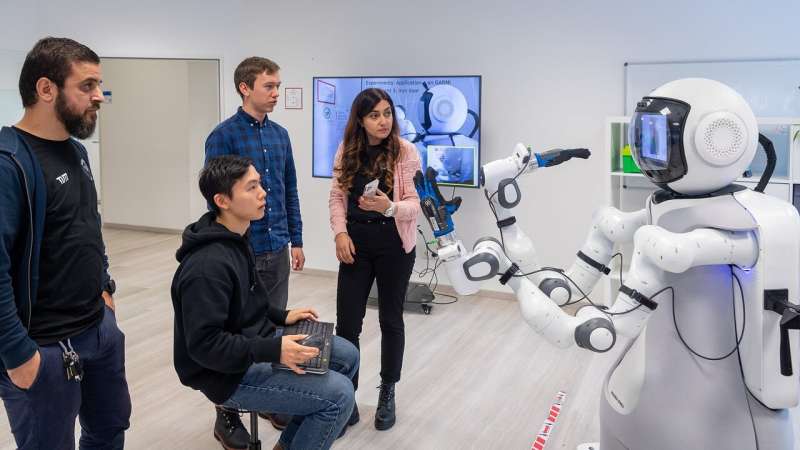This article has been reviewed according to Science X's editorial process and policies. Editors have highlighted the following attributes while ensuring the content's credibility:
fact-checked
trusted source
proofread
More transparency needed in human-robot interactions in nursing care, researchers say

It is essential in nursing care to have a transparent mapping of the entire human-robot interaction. That is the finding of the interdisciplinary research project Responsible Robotics, which researchers from TUM and the University of Graz completed in 2023. A data recorder helps to capture all events that occur when using a nursing care robot and make them visible and understandable for everyone involved.
Researchers are constantly testing new capabilities of the GARMI nursing care robot. But which ethical, legal and technical requirements should be established to help build trust in the use of robots in nursing care? This question was the focal point of the research project "Responsible Robotics," which brought together professors from various fields. The study was presented at the 2023 IEEE International Conference on Advanced Robotics and Its Social Impacts. Related findings were also published in ACM Transactions on Computer-Human Interaction.
Care is less tech-averse than expected
"We want to give tangible form to the societal dimension of technology," says Ruth Müller, a professor of science and technology policy. "The important thing is to identify potential effects of innovative technologies during the development process." In the context of "Robotics in care," robots can provide support with everyday work. However, their use can also fundamentally change important nursing care routines. That is why it is essential to integrate the perspectives of those providing care into the development process.
"The goal is for robots to support nursing staff in their work and expertise—not to replace them," says Prof. Müller, who sees robotics as a flexible technology, the social consequences of which "will depend on many decisions and the weighting of values during the development process."
In workshops and a project week with students, the researchers identified various perspectives on the topic. The needs of those receiving and providing nursing care and the desire for innovative technologies were discussed. "The nursing care perspective is much less averse to technology than is sometimes assumed," says innovation researcher Svenja Breuer from the Department of Science, Technology and Society (STS) of the TUM School of Social Sciences and Technology.
On the contrary, students of nursing care tend to see robots as an opportunity to automate processes and hand over burdensome documentation tasks. Nursing care researchers also critically assess whether robotics applications will truly improve the lives of elderly people and others needing nursing care.
Transparency for all concerned
A technology that has emerged from this interdisciplinary approach is the data recorder for the GARMI nursing care robot from the Geriatronics Research Center of the Munich Institute of Robotics and Machine Intelligence (MIRMI). The recorder logs and virtualizes the entire care process.
"We record all interactions with the robot to understand exactly what happened in case of an accident. This documentation is enormously important, especially with the vulnerable demographics such as the elderly and persons with physical and intellectual disabilities that we deal with," says STS team member Maximilian Braun.
The principle: With the aid of the data recorder, all procedures and interactions, for example in a rehabilitation treatment session, are processed and made visible—in a virtual and anonymized form. "This enables us to understand why something went wrong," says Svenja Breuer. Especially important for the development of the recorder, she adds, are not only the engineering, social sciences and legal experts, but above all the involvement of those who will later be interacting with the robots.
More information: Jon Skerlj et al, Data Recording for Responsible Robotics, 2023 IEEE International Conference on Advanced Robotics and Its Social Impacts (ARSO) (2023). DOI: 10.1109/ARSO56563.2023.10187414
Svenja Breuer et al, How Engineers' Imaginaries of Healthcare Shape Design and User Engagement: A Case Study of a Robotics Initiative for Geriatric Healthcare AI Applications, ACM Transactions on Computer-Human Interaction (2022). DOI: 10.1145/3577010



















